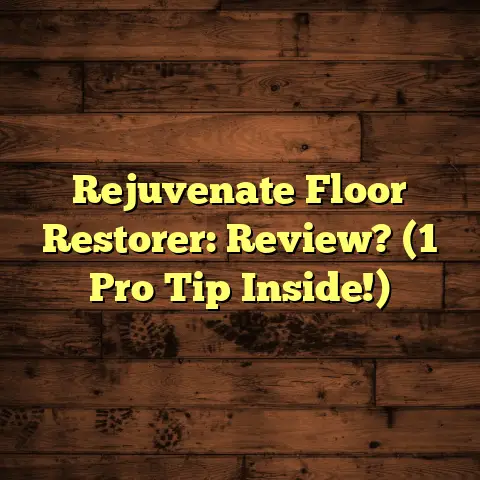Steam Clean Laminate? (3 Risks To Know NOW!)
I’m John, your friendly neighborhood flooring contractor, and today we’re diving into a hot topic – steam cleaning laminate floors.
Laminate flooring has totally revolutionized modern design, right?
It’s a superstar for its looks, toughness, and how easy it is to keep clean compared to, say, real hardwood or tile.
You get that wood or stone vibe without breaking the bank.
Now, steam cleaning?
It sounds like a dream – quick, easy, and no harsh chemicals.
But before you fire up that steamer, let’s pump the brakes.
There are some sneaky risks you need to know about.
Trust me, I’ve seen the aftermath of a steam cleaning session gone wrong.
So, grab a coffee, and let’s get into the nitty-gritty.
Understanding Laminate Flooring
Okay, let’s get down to basics.
What is laminate flooring, anyway?
It’s not just a solid piece of wood.
It’s actually made up of several layers pressed together.
Think of it like a multi-layered cake.
-
The Base: Usually a high-density fiberboard (HDF). This is the core, giving the floor its stability and resistance to impact.
-
The Decorative Layer: This is where the magic happens! A high-resolution image of wood, stone, or tile is printed onto this layer.
It’s what gives laminate its realistic look.
-
The Wear Layer: This is the top layer, a clear, protective coating made of melamine resin.
It’s designed to resist scratches, stains, and fading.
So, why is laminate so popular?
Well, for starters, it’s tough.
That wear layer can take a beating.
Kids, pets, clumsy adults – laminate can handle it.
It’s also a breeze to install.
Many types click together, making it a DIY-friendly project.
And let’s not forget the price tag.
Laminate is generally much more affordable than hardwood or tile.
Now, when it comes to cleaning, laminate is usually a champ.
Sweeping, vacuuming, and the occasional damp mop are usually all you need.
But then comes the question: “Can I steam clean it?”
That’s where things get tricky.
The Rise of Steam Cleaning
Steam cleaning has become a household staple, hasn’t it?
It’s that magical device that promises to blast away dirt and grime with nothing but water.
But how does it actually work?
Well, a steam cleaner heats water to a high temperature, creating steam.
This steam is then forced out through a nozzle or attachment.
The hot steam loosens dirt, kills bacteria, and sanitizes surfaces.
It’s like a spa day for your floors, right?
Steam cleaners have become popular for cleaning carpets, tiles, and even upholstery.
And, of course, laminate floors.
The appeal is obvious: a quick, effective clean without harsh chemicals.
Plus, who doesn’t love the idea of killing germs with just water vapor?
But, and this is a big but, this convenience can come at a cost when it comes to laminate.
Risks of Steam Cleaning Laminate Flooring
Alright, let’s get to the heart of the matter: the risks of steam cleaning laminate floors.
I’ve seen the damage firsthand, and it’s not pretty.
Risk 1: Moisture Damage
This is the biggest, baddest risk of them all.
Laminate flooring is not waterproof.
Remember that HDF core I mentioned earlier?
It’s basically compressed wood fibers.
And wood, as we all know, absorbs water.
When you steam clean, you’re introducing a lot of moisture to the floor.
Even if you think you’re being careful, that steam can seep into the seams between planks and the edges of the room.
What happens then?
The HDF core starts to swell.
This can lead to warping, buckling, and delamination (where the layers start to separate).
I once had a client who steam cleaned their laminate floors every week.
Within a few months, the edges of the planks were visibly swollen, and the floor felt soft and spongy in places.
The repair bill was not cheap.
To give you an idea, the absorption rate of the HDF core in laminate flooring can range from 8% to 20% when exposed to moisture, according to studies by the Composite Panel Association.
That’s a significant amount of water that can cause serious damage.
Risk 2: Reduced Lifespan
Even if you don’t see immediate warping or swelling, frequent steam cleaning can still shorten the lifespan of your laminate floors.
That protective wear layer, while tough, is not invincible.
The constant exposure to high heat and moisture can break it down over time.
This can lead to fading, dullness, and increased susceptibility to scratches and stains.
Think of it like repeatedly washing a delicate silk shirt in hot water.
Eventually, the fabric will start to wear down.
The same goes for your laminate floors.
According to the North American Laminate Flooring Association (NALFA), proper maintenance, including avoiding excessive moisture, is crucial for extending the life of laminate floors.
They recommend using a damp mop with a pH-neutral cleaner, rather than steam cleaning.
Risk 3: Warranty Violations
Here’s a kicker that many homeowners don’t even consider: steam cleaning can void your laminate flooring warranty.
Most manufacturers have specific guidelines for cleaning and maintaining their products.
And guess what?
Steam cleaning is often explicitly prohibited.
Why?
Because they know the risks of moisture damage.
If you have a problem with your floor and the manufacturer determines that you’ve been steam cleaning it, they can deny your warranty claim.
That means you’re stuck footing the bill for repairs or replacement, even if the problem wasn’t directly caused by the steam cleaning.
Always read the fine print of your warranty before using any cleaning method.
It could save you a lot of money and headache in the long run.
I can’t stress this enough.
I’ve seen manufacturers deny claims because of steam cleaning.
It’s a gamble you don’t want to take.
Alternatives to Steam Cleaning
Okay, so steam cleaning is a no-go.
But how do you keep your laminate floors clean and looking their best?
Don’t worry, there are plenty of safe and effective alternatives.
-
Microfiber Mops: These are your best friend. They’re gentle, absorbent, and can pick up dirt and dust without scratching the floor.
Make sure to use a mop with a removable, washable pad.
-
Damp Cloths: For spot cleaning, a damp cloth is all you need.
Just make sure it’s not soaking wet.
You want it to be barely damp to the touch.
-
pH-Balanced Cleaners: If you need a little extra cleaning power, use a pH-balanced cleaner specifically designed for laminate floors.
These cleaners are formulated to remove dirt and grime without damaging the floor’s finish.
Avoid using harsh chemicals, abrasive cleaners, or anything that contains wax or oil.
These can leave a dull film on the floor.
The key is to use as little water as possible.
Laminate floors don’t need to be soaked to get clean.
In fact, less is more.
Always follow the manufacturer’s recommendations for cleaning.
They know their product best, and their guidelines will help you keep your floors looking great for years to come.
Here’s a quick table summarizing the dos and don’ts of cleaning laminate floors:
| Cleaning Method | Safe? | Notes |
|---|---|---|
| Steam Cleaning | No | Can cause moisture damage, void warranty |
| Microfiber Mop | Yes | Use with a pH-balanced cleaner or just water |
| Damp Cloth | Yes | For spot cleaning, make sure it’s barely damp |
| Harsh Chemicals | No | Can damage the finish and leave a dull film |
| Abrasive Cleaners | No | Can scratch the floor |
| Wax or Oil-Based Cleaners | No | Can leave a sticky residue |
Conclusion
So, there you have it.
Steam cleaning laminate floors might seem like a quick and easy solution, but the risks far outweigh the benefits.
Moisture damage, reduced lifespan, and warranty violations are all serious concerns.
Laminate flooring is a fantastic option for homeowners who want a beautiful, durable, and affordable floor.
But like any investment, it needs to be properly cared for.
By avoiding steam cleaning and using safe, gentle cleaning methods, you can keep your laminate floors looking their best for years to come.
Now, I’d love to hear from you.
What are your experiences with laminate floor maintenance?
Have you ever had a mishap with steam cleaning?
Share your thoughts and tips in the comments below!
Let’s learn from each other and keep our floors looking fabulous.
Happy cleaning!





